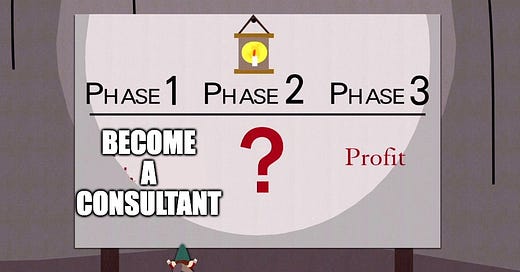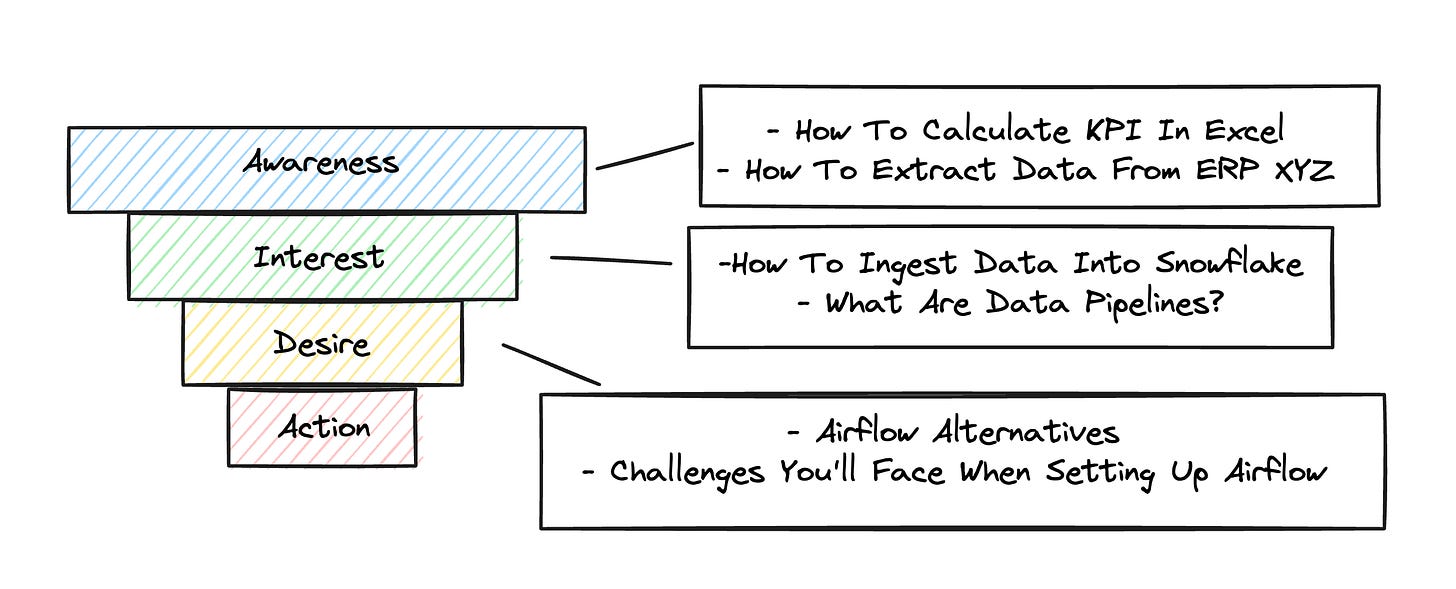Maximizing Value in Marketing: Lessons for Independent Consultants
One of the continuous problems that many consultants I talk to face is understanding how to get clients to get in front of clients.
Do you send out cold DMs, do you go through your network, etc?
It is challenging to get in front of clients. But far from impossible. You will need to actually take the time to understand your clients and really try to meet them where they are at.
But I don’t just want to tell you that one line; I want to walk you through how you can create a marketing plan.
I also will be going through a few past examples of my content that I know really resonated with my target clients.
In turn, it helped me land clients and I believe it can help you as well!
So let’s dive in!
Step One - Understand Your Clients Pain Points
The first step you’ll need to take is to figure out a problem that you want to solve, that your prospects have and are willing to pay to have solved.
That’ll become the focus of your next 6-12 months.
A marketing campaign if you will.
A key part of that statement is that your prospects need to have the problem and be willing to pay for it to be solved. If you put all your effort into creating content and marketing materials behind a problem that no one needs solving, well, there goes 6-12 months.
But how do you find a problem worth spending 6-12 months on?
Here are a few steps I’d take to understand your future clients better.
Talk to possible prospects and people in your network - Before you go invest the next year of your life, you need to be clear that you are working to solve the right problem. A great way to do this is to talk to other people in your network (and if you can, possible prospects) and understand what problems they are dealing with. Honestly, I wouldn’t come up with a problem you already think is worth solving. Then your conversation might end up biased and heading towards your problem. Instead, you want to come into the conversation with an open mind. You might find a very obvious problem that everyone else has missed.
Research - On top of talking to possible prospects, you can also dig into various channels where your prospects might analyze what they talk about. This could be communities like Slack or Reddit. You might also want to consider listening to podcasts where people who fit your target persona are. The benefit of the web is that you can find a lot of information about what is going on in the industry everywhere.
Test out ideas - You don’t have to commit to an idea right away. Instead, you can test out short-form content and see how your possible audiences respond. What I love about short-form content, may it be Linkedin or Twitter, is you can post and see who responds. So not only do you get to see if people in general resonate with the idea. But you can also see if your target persona seems to connect with the idea. So before writing 20,000 words on under water basket weaving, spend some time seeing if people actually care about a topic.
In the end, if you want to ensure you don’t waste your time. Don’t skip this step.
Step Two - Plan A Strategic Content Plan
Once you’ve started to find messaging and a general theme that seems to be working, then you can start to plan and put out content that helps answer the specific problems your prospects might be having that lead up to your solution.
My view on content is that you want to create content that helps your prospects up and down the marketing funnel. That is to say, if you look at the funnel below, your prospect doesn’t often start by looking up “Snowflake Data Consultant”.
In fact, they likely start by looking up something about perhaps certain KPIs they want to report on or how to extract data from a specific ERP or CRM.
Eventually they learn about a data warehouse and then eventually they might look for someone to help them implement it.
You want to meet them at all those different stages.
Not just when intent to buy is high. Everyone is targeting the bottom of the funnel.
Be better.
Here is another example. Let’s say your client is currently trying to find an open-source data pipeline solution. You might know that one of the most popular solutions out there is Airflow.
Ok, for those people who are very familiar with Airflow, you’ll know it’s technically a workflow orchestrator. But people use it to move data around.
You might create content such as:
How To Manage Python Script Dependencies
How To Ingest Data Into Snowflake
Best Open Source Data Pipeline Tools
Airflow Alternatives
Challenges You’ll Face With Airflow
How To Set Up Airflow
Each of these articles will hit a different stage in a person's search flow. They’ll likely start by first wondering how to get data from one point to another and start digging deeper and deeper.
Your goal will be to try to provide them value at every step. A lot of companies out there will focus heavily on the bottom of the funnel, usually with Google ads trying to really focus on buying intent. But if you’re a small independent consultant, you’re going to have a hard time winning that battle.
You’re not Deloitte you don’t have millions of dollars to spend on marketing. So instead, very targeted content that helps build trust is what you’ll likely need to rely on.
Step Three - Distribution Is King
Finally, an important aspect of content is that people need to see it!
Oddly enough, like trying to sell your service, you need to get your content in front of people. For that you need distribution.
Really, this entire process is simply you selling your services, one step at a time.
It might look something like the following:
First, you sell content and show that you can deliver valuable information
Then maybe you have a follow-up piece of content via a CTA
After that, you then have a consultation
Then a proposal
Finally, you hopefully have a client.
How do you distribute content?
You can:
Get good at SEO
Get good at Linkedin, Twitter, etc
Get good at Medium
Swapping links with other sites
Paid advertising
Start an email newsletter
You don’t have to do all of these at once. Test them out and see how they go for a few months.
Overall, marketing takes time. Your prospects will likely see a few different articles from you first and maybe they’ll click a few CTAs.
But that’s the general idea.
Don’t Forget These Key Truths About Marketing
To round off this article, I wanted to provide a few final pointers and a summary of this discussion.
So here are a few quick takeaways:
You need to create value - Marketing shouldn’t be a throwaway task. You don’t just want to post online saying “Hey I am a data person that can solve your data needs.” Show, don't tell. Give examples and create content that already helps people with their data problems before they even sign a contract.
You need to get in front of people one way or another - At the end of the day, you will need to sell yourself. You need to get in front of people. If you don’t want to do that, then I’d say you should either hire an employee or ensure you have a partner who is willing to sell.
Money only solves some problems - I have seen many people spend tens if not hundreds of thousands of dollars marketing. They’ll rebrand, they’ll pay for ads, they’ll do anything other than the work. They think they already know what people want so they try to get in front of them. But it really is only part of the problem. People still need to get value from your content or marketing.
Don’t only target purchasing signals - Many marketing and sales teams only target the bottom of the funnel. That can work when you already have brand value. People know who you are. But if you’re new, you have to provide value early and often. So create content that meets people at multiple parts of the marketing funnel.
With that, thanks for reading.
Past Newsletters You Might Want To Read!
Why Everyone Loses When You Charge By The Hour - Becoming A Better Consultant
Why Chasing Money Can Hurt Your Earnings (And What to Do Instead)
Day In The Life Of A Data Consultant
Join My Technical Consultants Community
If you’re a data consultant or considering becoming one then you should join the Technical Freelancer Community! I recently opened up a few sections to non-paying members so you can learn more about how to land clients, different types of projects you can run, and more!
Starting Your Own Consulting Company Today
Looking to start your own data analytics consulting company? Not sure how to attract clients, partner with the best vendors, or choose projects you're passionate about?
I've been there. In my Technical Freelancer Academy, I share how I built a successful data analytics consulting business from the ground up. A business that made it possible for me to quit my data engineering job at Facebook.
See you there!





